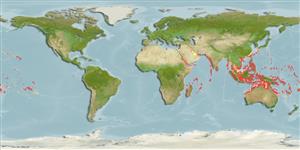Common names from other countries
Environment: milieu / climate zone / depth range / distribution range
экология
морской ассоциированный с рифами; пределы глубины 0 - 60 m (Ref. 128797). Tropical; 35°N - 26°S, 32°E - 122°W
Indo-Pacific: Red Sea, East Africa eastward through northern Australia reaching to Line and Tuamotu islands, north to southern Japan.
Size / Вес / Возраст
Maturity: Lm ? range ? - ? cm
Max length : 75.0 cm TL самец/пол неопределен; (Ref. 9710)
колючие лучи спинного плавника (общее число) : 3; членистые (мягкие) лучи спинного плавника (общее число) : 24 - 26; колючие лучи анального плавника: 0; членистые (мягкие) лучи анального плавника: 22 - 24. Fish has a deep grove before eye; scaleless area around lips, continuing and narrowing posterior to corner of mouth; small forward-curving spines in about five rows on side of and a short distance anterior to caudal peduncle. Caudal peduncle compressed (Ref. 9770).
Recorded from lagoons, seaward reefs (Ref. 1602) and sheltered inner reef slopes (Ref. 48637). Juveniles often associated with isolated patches of branching coral or rubble of shallow sandy protected areas. Adults occur singly or in pairs on the slopes of deep lagoon or seaward reefs (Ref. 37816, 48637). Often hostile towards divers and may attack unprovoked when caring for eggs (Ref. 48637). Feed on sea urchins, coral, crabs and other crustaceans, mollusks and tube worms. Oviparous (Ref. 205). Largest triggerfish; females are reported to have attacked divers when guarding their nest (Ref. 2334). Also caught with drive-in nets. Marketed fresh and dried-salted (Ref. 9770).
Life cycle and mating behavior
Maturities | размножение | Spawnings | Egg(s) | Fecundities | личинки
Distinct paring (Ref. 205).
Matsuura, K., 2001. Balistidae. Triggerfishes. p. 3911-3928. In K.E. Carpenter and V. Niem (eds.) FAO species identification guide for fishery purposes. The living marine resources of the Western Central Pacific. Vol. 6. Bony fishes part 4 (Labridae to Latimeriidae), estuarine crocodiles. FAO, Rome. (Ref. 9770)
Статус Красного Списка МСОП (Ref. 130435)
CITES (Ref. 128078)
Not Evaluated
Угроза для людей
Reports of ciguatera poisoning (Ref. 1602)
Использование человеком
рыболовство: коммерческий
дополнительная информация
инструменты
Специальные отчеты
Скачать в формате XML
ресурсы в Интернет
Estimates based on models
Preferred temperature (Ref.
115969): 25 - 29, mean 28.1 (based on 1016 cells).
Phylogenetic diversity index (Ref.
82804): PD
50 = 0.7500 [Uniqueness, from 0.5 = low to 2.0 = high].
Bayesian length-weight: a=0.03311 (0.02062 - 0.05319), b=2.97 (2.83 - 3.11), in cm Total Length, based on LWR estimates for this species & (Sub)family-body (Ref.
93245).
Trophic level (Ref.
69278): 3.3 ±0.44 se; based on food items.
устойчивость к внешним воздействиям (Ref.
120179): низкий, минимальное время удвоения популяции 4.5-14 лет (Preliminary K or Fecundity.).
Fishing Vulnerability (Ref.
59153): Moderate to high vulnerability (50 of 100).
